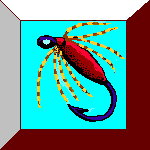


The three genera of the family Caenidae constitute North America's smallest mayflies, with the average size of about 4 mm. Despite their minute dimensions, they are of tremendous importance to the angler. The most significant characteristic of the nymphs are the operculate gills of segment 2, which almost completely cover the ones behind. The nymphs are sprawlers, have three tails, and are densely covered with fine hairs. Adults have whitish, well-developed wings, displaying few crossveins and no marginal intercalary veins. The lateral ocelli are very prominent, and hind wings are absent.
Nymphs are very similar to Caenis except that three prominent conical projections arise from the head, one above the base of each antenna and one over the middle ocellus. Also, as in Caenis, the enlarged gills of segment 2 overlap on the midline, but are more rounded on the outer margin. The forelegs are relatively short and separated widely at their base. Adults are a little larger than Caenis and a little lighter in color than Tricorythodes. The nymphs seem to prefer slower and warmer water than Tricorythodes, so they are found less frequently in trout streams.